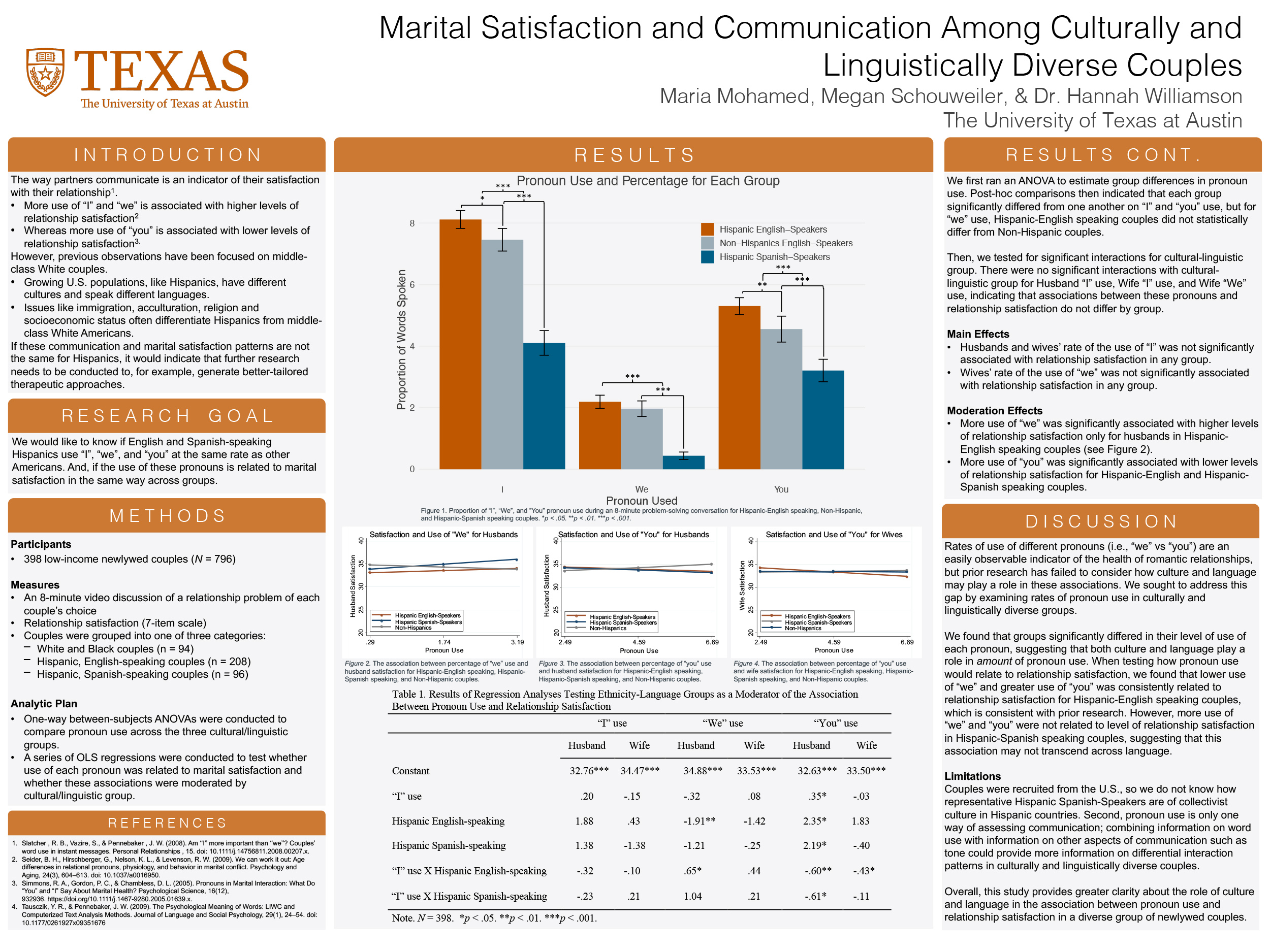Maria Mohamed, Megan Schouweiler, & Dr. Hannah Williamson
Communication patterns are indicative of marital satisfaction for traditional White American spouses. Using the pronouns “I” and “we” in conversation with a partner, can indicate that someone is satisfied in the relationship. Whereas the opposite is true for second-person pronouns like “you”. Little is known, however, about how this phenomenon applies to Hispanic couples. The aim of this study is to identify if first-person pronouns are related with martial satisfaction for Hispanic couples in the same way that they are for Non-Hispanic White couples. Presuming that all Hispanic couples hold a collectivist culture, I predict that pronouns “I” and “you” will not be correlated with marital satisfaction for them, but “we” will. Video transcriptions from 400 newlywed couples (N = 800) discussing a topic of their choice will be analyzed using a word analysis program called Linguistic Inquiry and Word Count (LIWC). The quantified pronouns (“I”, “you”, and “we”) will be correlated with self-reported marital satisfaction for Hispanic and Non-Hispanic couples separately and then compared.

Comments
This topic is really interesting. I have two questions. 1) How did you recruit for this study? I’m impressed by your sample size. 2) Why do you think “we” usage was only significant in Hispanic-English couples? And why was there a gender difference? – Avery Largent
Hey Avery, thank you! To answer your first question, I did not actually have to recruit for this study. My advisor had previously recruited the participants using marriage license records from the LA area (which were made public at the time). I could not have recruited this many newlyweds, so I am very thankful Dr. Williamson had this dataset available. As for the second question, from previous research, lower use of “we” is known to be associated with lower marital satisfaction for White and Black-English speaking couples and now for Hispanic-English speaking couples as well. The reason could be because the English-speaking Hispanics have acculturated more to traditional American, individualistic culture than Spanish-speaking Hispanics. They chose to speak English with their partner which it might signify that they have been in the U.S. for more generations, perhaps higher levels of acculturation. As to why there is a gender difference, in the papers I read leading up to this I found that higher use of “you” was more commonly found to be associated with marital dissatisfaction than higher use of “we” and “I” with marital satisfaction. So, the correlation between “you” and marital satisfaction is generally more pronounced from what I read. “You” use was the only one significantly associated with anything for wives so that could be the explanation. However, I am sure there are other interesting possible explanation for it and it may very likely be due to something else. I’d love to hear your theory! – Maria Mohamed
This was a very clear and easy-to-understand poster. I notice that you had a very large number of participants. Are there other questions you’re investigating with this same dataset? – Rob Reichle
Hi Rob, thank you for your question. Yes, the participants were recruited several years ago by my advisor (Dr. Williamson) and the team she was working with at the time in UCLA. There’s actually eight papers already published using this dataset and there may be more in the future but I’m not sure what the questions for future ones would be. Some of the titles to published research using this dataset are “Premarital education and later relationship help-seeking”, “Communication moderates effects of residential mobility on relationship quality among ethnically diverse couples”, and “Communication behavior and relationship satisfaction among American and Chinese newlywed couples”. The latter is very similar to this study. Please let me know if you would like a more extensive list or more info! – Maria Mohamed

